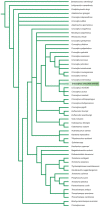Old African fossils provide new evidence for the origin of the American crocodiles
- PMID: 32703957
- PMCID: PMC7378212
- DOI: 10.1038/s41598-020-68482-5
Old African fossils provide new evidence for the origin of the American crocodiles
Abstract
Molecular and morphological phylogenies concur in indicating that the African lineages formerly referred to Crocodylus niloticus are the sister taxon the four Neotropical crocodiles (Crocodylus intermedius, C. moreleti, C. acutus and C. rhombifer), implying a transoceanic dispersal from Africa to America. So far the fossil record did not contribute to identify a possible African forerunner of the Neotropical species but, curiously, the oldest remains referred to the African C. niloticus are Quaternary in age, whereas the oldest American fossils of Crocodylus are older, being dated to the early Pliocene, suggesting that another species could be involved. We re-described, also thanks to CT imaging, the only well-preserved topotipic skull of Crocodylus checchiai Maccagno, 1947 from the late Miocene (Messinian) African site of As Sahabi in Libya. As previously suggested on the basis of late Miocene material from Tanzania, C. checchiai is a valid, diagnosable species. According to our phylogenetic analyses, C. checchiai is related to the Neotropical taxa and could be even located at the base of their radiation, therefore representing the missing link between the African and the American lineages.
Conflict of interest statement
The authors declare no competing interests.
Figures






References
-
- Uetz, P. & Hošek, J. The Reptile Database. https://www.reptile-database.org (2019). Accessed 5 Nov 2019.
-
- Nicolaï MPJ, Matzke NJ. Trait-based range expansion aided in the global radiation of Crocodylidae. Glob. Ecol. Biogeogr. 2019;1:2. doi: 10.1111/geb.12929. - DOI

